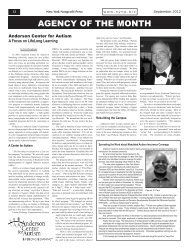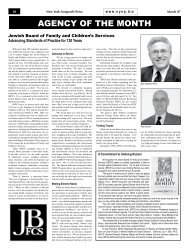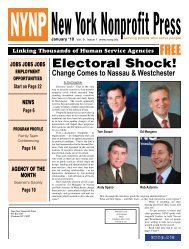March Edition 2011 - New York Nonprofit Press
March Edition 2011 - New York Nonprofit Press
March Edition 2011 - New York Nonprofit Press
Create successful ePaper yourself
Turn your PDF publications into a flip-book with our unique Google optimized e-Paper software.
8 <strong>New</strong> <strong>York</strong> <strong>Nonprofit</strong> <strong>Press</strong> www.nynp.biz <strong>March</strong> <strong>2011</strong><br />
TRIPLE POINT THREAT OF VIEW<br />
continued from page 1<br />
Governor Cuomo Proposes $9 Billion in Cuts<br />
is likely to contain significant cuts, particularly in<br />
light of President Obama’s own budget proposal<br />
for FY<strong>2011</strong>-12 which includes reductions in a<br />
number of programs and a 50% cut to the Community<br />
Services Block Grant which funds Community<br />
Action Agencies.<br />
This next deluge of federal funding reductions<br />
– <strong>New</strong> <strong>York</strong> State would lose at least<br />
$1.2billion in just some selected programs – is<br />
likely to trigger an entire new round of budget<br />
cuts at the State and local level.<br />
In the meantime, advocates are attempting<br />
to buck up their courage and put up a fight. The<br />
Human Services Council of <strong>New</strong> <strong>York</strong> is coordinating<br />
a new “Who Cares? I Do” campaign,<br />
intended to inform the general public about the<br />
critical importance of human services for all<br />
<strong>New</strong> <strong>York</strong>ers. Individual sector specific coalitions<br />
are mounting their own battles to fight specific<br />
budget cuts.<br />
Here are at least some details on the specifics<br />
of proposed cuts in the federal, state and city<br />
budgets.<br />
Governor Andrew M. Cuomo got the<br />
budget season off to painful start on February<br />
1st when he laid out his plans to eliminate<br />
<strong>New</strong> <strong>York</strong> State’s $10 billion budget deficit for<br />
FY<strong>2011</strong>-2012 which begins on April 1st. As<br />
promised, he relied almost entirely on spending<br />
cuts -- $8.9 billion in recurring spending actions,<br />
or nearly 90 percent of the total plan. The<br />
budget proposes gap-closing actions in almost<br />
every area of state spending and includes yearto-year<br />
reductions in the two largest drivers of<br />
State expenditures, Medicaid and School Aid.<br />
“<strong>New</strong> <strong>York</strong> is at a crossroads, and we must<br />
seize this opportunity, make hard choices and<br />
set our state on a new path toward prosperity,”<br />
Governor Cuomo said. “We simply cannot afford<br />
to keep spending at our current rate. Just<br />
like <strong>New</strong> <strong>York</strong>’s families and businesses have<br />
had to do, <strong>New</strong> <strong>York</strong> State must face economic<br />
reality. This budget achieves real, year-to-year<br />
savings while restructuring the way we manage<br />
our state government. This is the first step toward<br />
building a new <strong>New</strong> <strong>York</strong>.”<br />
The Center for <strong>Nonprofit</strong> Strategy and Management<br />
Presents<br />
CONSULTING DAY<br />
FOR NEW YORK CITY’S NONPROFIT COMMUNITY<br />
SAVE THE DATE!<br />
WEDNESDAY, MARCH 16 <strong>2011</strong>,<br />
8:30AM-4:00PM<br />
Baruch College, William and Anita <strong>New</strong>man Vertical Campus<br />
<strong>New</strong>man Campus Conference Center, 14th Floor - 55 Lexington Avenue @ 24th Street<br />
COST: FREE<br />
A Great Opportunity for You To:<br />
• Meet one-on-one with a consultant and discuss the challenges facing your<br />
organization in areas including:<br />
Budgeting, Finance, & Accounting<br />
Entrepreneurship & Social Enterprise<br />
Executive Director<br />
Faith-Based Organizations<br />
Financial management<br />
Fundraising<br />
How to Approach Philanthropists<br />
Human Resource<br />
Legal Issues<br />
Marketing & Communications<br />
Program Evaluation & Outcomes<br />
Strategic Planning<br />
• Attend workshops led by experts in the nonprofit sector<br />
• Network with over 100 leading nonprofit organizations in NYC<br />
Space is limited – Appointments will be required<br />
Appointments and workshop registrations must be made in advance<br />
Appointments will be given on a first-come, first-served basis<br />
Maximum two consultations in two focus areas per attendee<br />
FOR SPECIFIC OPPORTUNITIES TO MEET WITH CONSULTANTS, AND<br />
FOR RSVP INFORMATION:<br />
www.baruch.cuny.edu/spa/researchcenters/nonprofitstrategy/events.php<br />
PLEASE NOTE: Consultants providing advice in connection with this event are<br />
doing so as individuals. Consequently, all advice provided is theirs alone. The<br />
Center for <strong>Nonprofit</strong> Strategy and Management at Baruch College School of<br />
Public Affairs assumes no responsibility for it.<br />
Many of the details of what certainly would<br />
be devastating cuts to vital services remain unclear,<br />
even after Cuomo’s presentation of his<br />
Executive Budget on February 1st. In large<br />
part, this is due to the Governor’s use of special<br />
commissions to identify the specifics of billions<br />
in “savings”, creation of new block grants<br />
to mask cuts in specific services, and substantial<br />
transfers of funding responsibility from the<br />
State to localities and school districts.<br />
Medicaid<br />
In one of the largest and most complex<br />
areas of the State budget, the Governor tasked<br />
his Medicaid Redesign Team (MRT) to identify<br />
$2.85 billion in savings and submit their recommendations<br />
to him by <strong>March</strong> 1st. (See: article<br />
on page 11.)<br />
“Including the commensurate loss of federal<br />
matching funds, the Governor’s proposed<br />
health care cuts amount to approximately $15<br />
billion over two years,” said Daniel Sisto, President<br />
of the Healthcare Association of <strong>New</strong> <strong>York</strong><br />
State (HANYS). “This is the largest cut to<br />
health care services in <strong>New</strong> <strong>York</strong> State’s history.<br />
Even within the context of our fiscal crisis, the<br />
magnitude of these cuts is extreme. I am gravely<br />
concerned about the expectation that the Governor’s<br />
Medicaid Redesign Team can identify<br />
alternative reforms to substitute for this level of<br />
reduction. The Medicaid Team does not need<br />
more health experts. It will require alchemists,<br />
not policy wonks or providers, to transform cuts<br />
of this magnitude into gold.”<br />
Education<br />
On the education front, the Governor is<br />
proposing another cut of $2.85 billion, relative<br />
to current financial plan projections for<br />
FY<strong>2011</strong>-12 -- a year-to-year reduction of $1.5<br />
billion compared to spending for FY 2010-11.<br />
This represents a 7% reduction in state aid to<br />
education. Local school districts, the Governor<br />
argued, can make up for the cut through use of<br />
$1.2 billion in existing reserves, $600 million<br />
in left over federal funding and other management<br />
efficiencies. Cuomo took aim at local district<br />
administrations, noting that 40% of school<br />
district superintendents receive salaries and<br />
benefits of $200,000 or higher. He questioned<br />
“why they get paid more than the governor of<br />
the state”. “Let’s find savings within the bureaucracy,”<br />
he said.<br />
Direct Operations and<br />
Consolidation of Services<br />
The Governor’s budget proposes a variety<br />
of ways to restructure state government and find<br />
efficiencies and savings – many with implications<br />
for the provision of human services.<br />
The budget reduces General Fund State Operations<br />
spending by 10 percent at State agencies.<br />
Commissioners and agency heads will be<br />
instructed to maximize savings in non-personal<br />
services. The Governor also intends to achieve<br />
workforce savings, including the negotiation<br />
of a wage freeze. Contracts covering the vast<br />
majority of State employees are up for renewal<br />
at the outset of the <strong>2011</strong>-12 State Fiscal Year.<br />
“If workforce savings cannot be accomplished<br />
jointly, as a last resort up to 9,800 layoffs would<br />
be necessary,” said the Governor.<br />
The Executive Budget proposes to merge<br />
or consolidate 11 separate State entities into<br />
four agencies to streamline and eliminate duplicative<br />
bureaucracy, better align State responsibilities<br />
with need and improve services<br />
through superior coordination. Proposals include<br />
merging the Department of Correctional<br />
Services and the Division of Parole into the<br />
new Department of Corrections and Community<br />
Supervision; and consolidating the Office<br />
for the Prevention of Domestic Violence, the<br />
Office of Victim Services and the State Commission<br />
of Correction into the Division of<br />
Criminal Justice Services.<br />
The Governor is also proposing to reduce<br />
excess capacity in prisons, youth detention and<br />
mental hygiene facilities. To speed this process,<br />
he is proposing to eliminate the statutory<br />
12-month notification prior to closures.<br />
Actions for youth and mental hygiene facilities<br />
will be taken following analysis of vacancy<br />
rates, service utilization, and other factors.<br />
The budget calls for reducing the number<br />
of juvenile justice facility beds operated by<br />
Office of Children and Families (OCFS) by approximately<br />
30 percent and replacing them with<br />
community-based programs.<br />
For prisons, actions to eliminate an estimated<br />
3,500 prison beds will be implemented<br />
pursuant to recommendations of a task force<br />
created by Executive Order. Interestingly, the<br />
task force will identify affected facilities – and<br />
the communities in which they are located – after<br />
the budget is scheduled to be approved. The<br />
budget does allocate $100 million in economic<br />
development aid for affected areas.<br />
Funding Shifts and Reductions<br />
in Aid<br />
The governor also reduced levels of funding<br />
for localities by 2% -- except for <strong>New</strong><br />
<strong>York</strong> City where the Mayor claims that there<br />
was a 100% reduction -- and proposed a variety<br />
of other funding shifts, many with significant<br />
implications for individual program sectors.<br />
Mayor Michael Bloomberg immediately<br />
claimed that the Governor’s budget had cut $2<br />
billion in funding for the City. Among the human<br />
service program areas where the Governor<br />
proposes to reduce or eliminate State share expenditures<br />
(along with the state’s estimates of<br />
the savings) are:<br />
• Support for severely disabled students in residential<br />
schools, i.e. CSE placements, eliminated<br />
($69 million);











